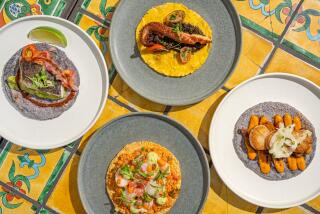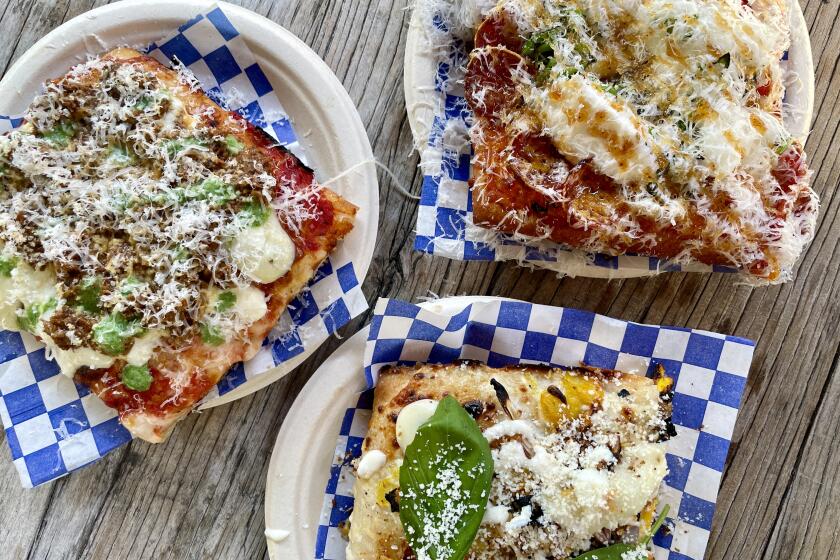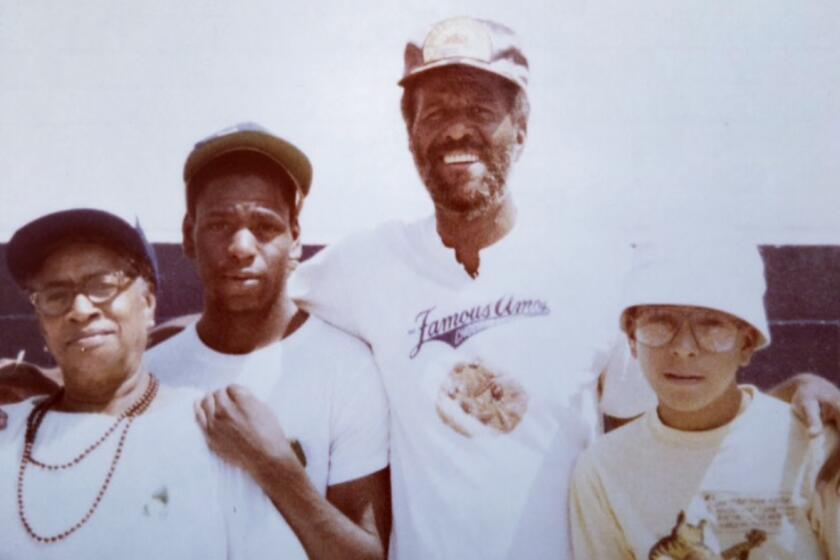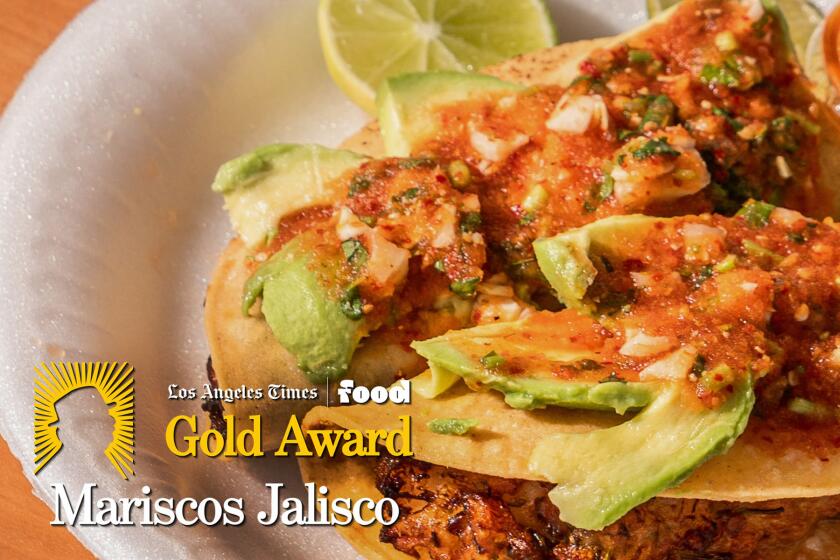As dollar falls, wine price tags pop corks
Last week, a shopper at Wine Expo in Santa Monica noticed something odd. A magnum of Champagne -- Pierre Peters Cuvee de Reserve Blanc de Blancs Grand Cru le Mesnil -- sat in the refrigerator priced at $81. The identical bottle was there on a shelf for $97.
This was not a pricing error but a snapshot of a wine market starting to go wild. For months, the buzz in the wine world has been that wine prices are about to soar. Now it looks as though it’s happening.
With the dollar having plummeted against the euro almost 25% in the last year, the prices of wines from a number of European regions have, or are about to, suddenly skyrocket.
As for the Pierre Peters pricing, Wine Expo general manager Robert Rogness explains that the discrepancy simply reflects the higher price the store paid for its latest shipment. “When we reloaded,” he says, “the price went up that much. We do not up-charge the merchandise on the floor based on the new shipment price.”
At one Hollywood wine shop, white Burgundy prices have escalated dramatically. According to Jeff Kavin, owner of Greenblatt’s Deli, wholesale prices for the 2002 vintage are up about 30% from the previous one. “A little more than a year ago we were paying $33.25 a bottle,” he says. “In the summer we went back and ordered more and paid $43.” Because he did not have a stock of this particular wine purchased when the dollar was stronger, Kavin has had to raise prices accordingly, a maneuver he has been able to avoid with many wines thus far. When he goes back for more white Burgundy very soon, he expects to pay $50.
Many 2000 Barolos (the latest vintage to have been released) are priced 10% to 40% higher than the 1999s. Some 2000s doubled in price after the vintage became the first to receive a “perfect” rating of 100 points from the Wine Spectator.
“It’s the first time Americans have had to deal with devalued currency,” says Rogness. “In the past, it’s always been, ‘Woo-hoo, the lira’s down! Let’s go to Italy!’ Now they’re going to be paying more for their Barolo.”
And then there’s Champagne. At the Wine House in West Los Angeles, Louis Roederer Cristal (750 milliliters) is going for $200 this year, up from $150 last year. Wine buyer Jim Knight says overall he has seen a 10% to 20% increase in Champagne prices over the last six months.
Rogness says he has watched his Champagnes and many other imported wines go up about 5% to 8% a month for the last six months. “It’s not so much about the price of the wines as it is about the price of the euro,” he says.
Not all imported wines have seen such dramatic increases, partly because of competition among a larger number of European wineries and partly because wine merchants have been loath to shock -- and lose their market. “We’ve been better able to manage and modulate the prices of those wines,” says Rogness.
But with Champagne, it seems, the currency issue is amplified by market forces. There are relatively few small-grower Champagnes, and consumers, who need to hear that “pop” on New Year’s Eve or other festive occasions, are tremendously loyal to them. Hence at Wine Expo, the retail price of L. Aubry Fils “Le Nombre d’Or Campanae Veteres Vites” a Jouy-les-Reims increased, in three consecutive vintages, from $41.99 to $49.99 to, this year, $73.
There’s no end in sight: Wine merchants expect prices to continue to rise. Bob Golbahar, president of Twenty Twenty Wine Merchants in West L.A., says he already has price sheets from wholesalers for the next few months. “Taittinger will go up a good 30%,” he says. “In a few months all of the European wines will go up 20% to 40%.”
The solution for some retailers is to steer customers toward wines that have not seen such steep increases.
For a small, newish boutique like Silverlake Wine, a Pierre Peters price increase is not an option. So the store simply stops carrying it. “We switch to things that maybe no one’s seen before,” says owner Randy Clement. “We’re too new to be alienating our customers. If we sell a wine that is terrific at $13, and next year it’s going to be $16, it’s no longer as terrific a wine. It’s not going to work at that price point. So we’re going to discontinue it.”
For Barolo lovers, Rogness says he has been seeking out “other Nebbiolo-based wines in the $40 range.”
Twenty Twenty’s customers have already shifted their buying habits. “This holiday season we’re selling 70% American wines and 30% European,” says Golbahar. “Most years we sell more French wines than American.”
Greenblatt’s Kavin says that though the prices have risen, consumers have been protected somewhat from the increases. “We’re selling the 2000 Bordeaux that we bought and brought into the country two years ago,” he explains. “So the dollar change is not reflected yet there.”
There are other natural market protections in place, Kavin says. Many importers bought foreign currencies in advance to hedge against what was happening to the dollar, and they were able to keep prices somewhat stable. “What’s going to happen is we’re going to run out of rope,” he says.
“Stores that can afford to warehouse the stuff don’t necessarily have to raise their prices yet,” says Wine House’s Knight. “Those who bring in, say, more than two shipments a year have to raise their prices.”
Then, of course, the quality of a vintage can be a factor, one that sometimes works in favor of consumers. Knight says that in the case of Bordeaux, the 2000 vintage was considered better than the 2003, “so the price there went down. But because the margin had increased, the price actually stayed the same on the shelves.”
Of course there is a possible silver lining for merchants, if not for the consumer. For some, the more a bottle costs, the more cachet it has, and the more a certain type of consumer is likely to spend.
“The price of tequila tripled in a year and a half,” recalls Rogness of Wine Expo. “I remember this one gentleman who thought tequila was only for frat boys. Suddenly he sees a bottle of tequila for $100 and decided he absolutely had to find out what all the fuss was about.”
Times staff writer David Shaw contributed to this report.
More to Read
Eat your way across L.A.
Get our weekly Tasting Notes newsletter for reviews, news and more.
You may occasionally receive promotional content from the Los Angeles Times.










